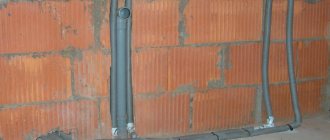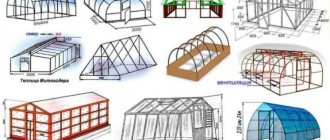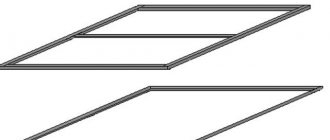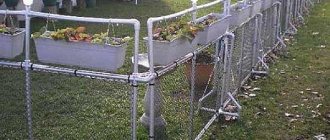Plastic as a shell for a foundation pillar has one important property - high resistance to moisture.
Supports for buildings made of plastic poles are used mainly in low-lying areas with high groundwater levels.
When arranging a foundation of this type, plastic pillars driven into the ground are filled with cement, and then connected into a single structure using a grillage.
We will tell you about making a columnar foundation from plastic pipes with your own hands in this article.
In what cases is it used?
You can build houses on a foundation made of pipes, the specific gravity of which does not exceed 1t/sq.m.
One-story buildings made of foam blocks, cinder blocks, wood and on a frame base are suitable for these parameters. Wooden and frame houses are generally very light. They can have 2 floors and are securely supported by plastic pillars filled with concrete.
Plastic helps out developers who build in lowlands, where a lot of melt and rainwater flows , and in areas with high ground flows.
Other materials in conditions of high humidity become less durable and quickly break down or become deformed. Plastic pipes intended for laying external sewage systems are not harmed by moisture.
In this case, PVC pipes serve as permanent formwork for concrete pillars. By themselves, they are not very strong, but filling them with reinforced concrete makes them useful in the construction of foundations.
Houses made of heavy building materials cannot be built on supports made of plastic pipes. Heavy buildings require a more solid foundation in the form of a strip or monolithic foundation. It is undesirable to use them in severe frost conditions, where temperatures in winter can drop below 20 degrees.
Marking
The markings are applied in a certain sequence:
- Install pegs around the perimeter of the future foundation, making an indentation of 100 cm;
- Using a level, pull the cord between them strictly horizontally;
Marking on the site - It is necessary to drive a stake at the intersection of the cord - this will be the center of future pillars;
- At this stage, the cord is no longer needed; it can be removed.
The cord will still be needed during the installation process before installing the grillage.
Requirements for pipes
The foundation requires pipes intended for laying external sewerage. They are available in orange or brown and have enhanced characteristics:
- strength,
- durability,
- wear resistance,
- resistance to external influences.
In contrast, gray or white PVC pipes are intended for indoor use. Under conditions of increased mechanical loads, constant exposure to moisture and temperature changes, they will not last long. It is better not to use them when arranging the foundation.
Columnar foundation manufacturing technology
Further work will be divided into two stages, each of which requires responsible and step-by-step implementation.
Drilling wells and installing piles
- According to the markings, wells are made using a drill. The depth of the well should be 25 cm deeper than the soil freezing level, and the width should be 7 cm greater than the diameter of the PVC pipes. Due to possible collapses, you should not drill all the wells at once, it is better to make them sequentially;
- Using a shovel or a special drill attachment, an expansion is made at the bottom of the well with a height of 25 cm and a diameter of 12 cm;
- A cushion is made at the bottom of the well from a mixture of sand and gravel 20 cm thick;
- The pipe is inserted so that its surface practically coincides with the lower plane of the grillage.
- Using a level, mark the location of the lower part of the grillage on the pillars and, if necessary, cut the piles according to the markings;
The verticality of each pipe must be checked with a level and then secured.
Pipe concreting
- For convenience, pour the prepared concrete solution into a container and pour 20 liters into the cavity of the pipe; it is necessary to raise it by 20 cm. The concrete, spreading along the expansion, forms a heel. Cover the remaining space around the support with soil and compact it thoroughly;
- Insert a pre-welded frame of three reinforcement bars into the pipe so that their edge is 25 cm higher than the plastic pipe if you plan to install a reinforced concrete foundation. If the connection will be made with wood, then the reinforcement should be installed below the edge of the plastic pipes by 5-7 cm.
- Concrete should be poured in portions, with each layer carefully compacted using a vibrator or metal rod. In the latter case, it is necessary to act with the utmost caution so as not to damage the integrity of the plastic poles;
- Pour concrete solution until it reaches the level of the pipe;
- Fill the pipes completely with the solution, compact them, install a pin with a diameter of 10-12 mm (for a wooden grillage) into the pile and leave until completely hardened.
To prevent the solution from drying out, wet sawdust is placed on the surface of the pillars and covered with polyethylene until the concrete sets completely.
Video: Foundation for a utility room
Pros and cons of foundation foundation
Pros:
Low cost. Of all the materials that can serve as permanent, durable formwork, plastic is the most economical.- Convenience. The pipe already has the desired shape and the required diameter, so its use does not involve large labor costs.
- Light weight. PVC pipes are easy to install. In addition, they do not create additional pressure on the ground.
- PVC is not exposed to the negative effects of moisture and pests.
- Resistance to temperature changes and corrosive processes.
Minuses:
- If the temperature drops too much, the plastic may crack.
- Despite all its technical characteristics, plastic is less durable than stone. It can last a maximum of 85 years.
Required Tools
In order not to waste time during construction work, it is worth purchasing the required tools in advance:
- Shovel;
- Master OK;
- Hand mixer or concrete mixer;
- Boer;
- Construction level and tape measure;
- Black marker;
- Containers for solution (large buckets);
- Cord;
- Sledgehammer;
- Bulgarian.
Materials:
- Fittings (0.5 m longer than PVC pipes) at the rate of 3 pieces per post and wire for tying;
- Fine crushed stone;
- Wooden pegs;
- Cement grade M300 or M400;
- The required number of external sewer pipes with a diameter of 110-180 mm.
After purchasing the necessary materials and equipment, you can begin the installation work, which consists of several stages.
Possible errors during construction and ways to correct them
To keep the pipes securely at their level, a high-quality cushion is placed under them . When working with particularly mobile and loose soils, it is advisable to also place a stone platform under the cushion. If this is not done, the pillars may begin to fail.
In such cases, a tunnel is made under their base, after which a strip support is constructed. Or they raise the pillars to the required level, and then fasten them with reinforcement.
If the number and diameter of supports are incorrectly calculated, and the foundation cannot properly support the building, the process of deformation and destruction of the walls will begin. In such cases, it is necessary to dismantle and strengthen each support.
You will find a lot of important and useful information about columnar foundations here.
Preparatory process
Construction must begin by determining the depth of the foundation. This factor depends on the type of soil, the level of groundwater and freezing. Depending on this, the columnar base is:
- Unrecessed (up to 50 cm);
- Shallowly buried;
- Deeply buried (more than 150 cm).
During the preparation process, it is necessary to clear the area of debris, level the construction site and calculate the number of columns, taking into account the fact that the piles should be located at a distance of 2 m from each other (the greater the mass of the future structure, the smaller this distance).
At this stage, it is necessary to provide for the availability of electricity at the site, cut fittings and pipes to the required length.
Features of working on different soils
If there are aggressive waters of natural or industrial origin on the territory, it is better to carry out drilling work using asbestos-cement pipes. Strengthening the drill shaft is not carried out in cases with swelling and hard-plastic soils.
In these conditions, it is recommended to refrain from using the above technology. When the work is completed, the pipe sections are dismantled. Sometimes a project requires leaving them in the soil: this is done in order to further protect concrete piles from the effects of soil in areas with geological and seismic activity.
Formation of the reinforcing layer
Installation of a reinforcing layer is mandatory for the foundation, as it distributes the load along the column, and in the presence of heaving or loose soils, it eliminates deformation or damage to the structure. Structurally, it consists of four reinforcing bars with a diameter of 8-12 mm, located in cross-section at the corners of a square, with thick wire ligation along the length of the column at intervals of 1-1.2 m.
The length of the side of the square of the piping is determined taking into account the diameter of the pipe: the reinforcement should not touch its walls and be at a distance of 20-30 mm. When pouring concrete, the reinforcing structure must be completely immersed in the solution and not come into contact with the surface of the PVC pipe.
The reinforcement cage at the level of the sole should have an extension in the form of ends bent at right angles, and its length should be equal to the height of the pipe. It is formed on a flat surface, and then carefully lowered into a PVC pipe and centered.
How does UVF work?
So, to correctly lay the UFF, you need to go through a whole series of complex works; the quality of the foundation being built depends on the correctness of their implementation. For this purpose:
- It is necessary to decide on a place suitable for development.
- When choosing a location, all features of the landscape are taken into account.
- Marking should be done with a margin of approximately 0.5 m.
- The fertile layer of soil must be completely removed.
- Then a trench is dug at a depth equal to the level of the bedding and the most optimal height of the bedding layer.
- Next, drainage is installed.
- Waterproofing is installed under the pillow and reinforced.
- The formwork is being installed.
- A communications system is being installed.
This is a rather complex and responsible process that requires increased concentration of attention, and therefore, the help of specialists is sometimes simply necessary.
Areas of use
Plastic pipes are superior to their metal counterparts in many respects that are important for any application.
Main areas of use:
- Transportation of aggressive chemical liquids. Plastic does not react with many chemicals.
- In monolithic construction, PVC pipes are used for formwork in order to protect the sheet ties from the penetration of concrete during the pouring of the foundation.
- Use in compressed air transportation channels up to 30 atm.
- During the installation of wiring, plastic products are used to protect communications from possible mechanical deformations.
- In reclamation, irrigation and drainage systems.
- Poles for billboards are made from smooth pipe taking into account the customer’s sketches.
- Heating systems and plumbing installation.
- Plastic pipes are often used in the manufacture of furniture.
- Corrugated electrical pipes are used to protect cable and conductor products during installation by any means.
Features of working on different soils
If there are aggressive waters of natural or industrial origin on the territory, it is better to carry out drilling work using asbestos-cement pipes. Strengthening the drill shaft is not carried out in cases with swelling and hard-plastic soils.
In these conditions, it is recommended to refrain from using the above technology. When the work is completed, the pipe sections are dismantled. Sometimes a project requires leaving them in the soil: this is done in order to further protect concrete piles from the effects of soil in areas with geological and seismic activity.
Calculation of height above ground
The lifting height of piles depends on several conditions:
- The amount of snow cover in winter.
- Water level during floods or floods.
- Depth of groundwater.
Some values can be found in SNiP annexes, other values can be obtained from local geological exploration or meteorological organizations.
The main task is to ensure such a rise above ground level in order to minimize the consequences of various natural influences.
In most cases, the height of the bathhouse above the ground level is taken to be within 40-60 cm. To cut off the walls from contact with snow masses, this is usually enough, as in case of flooding.
No one can predict critical situations, and building a bathhouse that is too high is impractical.
This does not apply to buildings on slopes or uneven terrain, where the height is determined by the lowest value.
Main characteristics
A columnar foundation made of sewer pipes has many advantages:
- Installation work is completed faster due to the light weight of the base material. No need to use heavy construction equipment.
- The foundation is built on any type of soil, including heaving soil. Plastic sewer products have smooth outer walls, which reduces the impact of frost heaving of the soil.
- The cost of constructing the foundation is insignificant, thanks to the low price of plastic products and minimal earthworks.
- The durability of the columnar base is due to the resistance of the base material to corrosion, high humidity and aggressive environments.
The disadvantages of a tubular columnar base made of polymers include the following:
- Possibility of deformation of plastic at low air temperatures.
- When building a residential building on a columnar foundation, it is impossible to create a basement or basement.
- Polymer materials are not able to withstand heavy loads.
What it is
This is a relatively economical and high-quality foundation installed on plastic pillars. It is used in low-lying areas where groundwater is located close to the surface. Its main support is plastic pillars driven into the ground, which are filled with concrete and connected into a structure, forming a grillage.
This plastic base has high technical characteristics and is much cheaper than the base material of other types of bases used in such cases. A columnar foundation is easy to install with your own hands.
The weight of the entire building structure rests on the grillage and is transmitted into the ground through plastic piles. Thanks to the high strength and durability of the plastic material, the quality and durability of the structure remain at the required level.
Areas of use
Plastic pipes are superior to their metal counterparts in many respects that are important for any application.
Main areas of use:
- Transportation of aggressive chemical liquids. Plastic does not react with many chemicals.
- In monolithic construction, PVC pipes are used for formwork in order to protect the sheet ties from the penetration of concrete during the pouring of the foundation.
- Use in compressed air transportation channels up to 30 atm.
- During the installation of wiring, plastic products are used to protect communications from possible mechanical deformations.
- In reclamation, irrigation and drainage systems.
- Poles for billboards are made from smooth pipe taking into account the customer’s sketches.
- Heating systems and plumbing installation.
- Plastic pipes are often used in the manufacture of furniture.
- Corrugated electrical pipes are used to protect cable and conductor products during installation by any means.
Dependence of the choice of foundation on soil characteristics and groundwater characteristics
Let's consider the possibility of building a foundation from pipes. It should be borne in mind that this is by no means a universal foundation (excluding pile foundation with screw piles). In the case of complex soils and a large weight of the building, such a foundation will not be suitable; it is necessary to build more complex varieties - monolithic slab, monolithic strip, strip of blocks, monolithic pile. Therefore, in order to have absolute confidence in the correct choice of pipe foundation, you need to order a geodetic survey of your site. It will include a conclusion about the soils, their layered arrangement, the depth of groundwater, the depth of soil freezing and the presence of water “lenses” inside the soil.
Geodetic research must certainly precede the design of the future structure and accompany it as it progresses
Soils and their combinations
The classification of soils is presented in reference books; for example, in the textbook “Soils. Foundations. Soil characteristics. Choosing the optimal foundation":
- Rocky soils are, rather, crystalline rock, rock rather than earth, and sedimentary rock (dolomite, compressed sandstone, shale, shell rock, limestone). Any foundation is acceptable except a pile foundation (it is difficult to drill into rock).
- Conglomerates are fragments of varieties of rocky soils; do not erode or change in volume when freezing; Any foundation is acceptable.
- Non-rocky soils:
- bound - clayey and loamy; freeze deeply; capable of “floating” and moving, only heavy types of foundations are suitable;
- unbound - sandy and sandy loam soils; when wet they tend to move and freeze shallowly; Any type of foundation is suitable.
Different soils that may be found on your site
Knowing this list, you can approximately determine the type of your soil yourself: drill a hole with a garden drill and study soil samples from different depths.
As a result of geodetic work, you will receive complete information about the condition of your site
If a soil sample moistened with water can be kneaded like dough, then your soil is loam. If the earth dissolves in water, it contains a large percentage of loamy component. If sediment falls, there will be clay at the bottom and sand above it.
To determine the type of soil, you need to place the sample in a glass of water
If you have good, stable soil on your site - a mass of rock, untouched sandstone, or sedimentary rocks, or sand, or dense loamy soils, then a foundation made of pipes is quite suitable for any light building such as a frame house, veranda, gazebo, barn. A foundation made of screw piles is suitable for any construction on any soil.
Soil freezing depth
The freezing depth in central Russia is about one meter, but deviations are possible. The lowest point of the base of any buried foundation must be below the freezing point of the soil. This most often does not apply to pipes (except for screw piles).
Freezing depth is a factor influencing the foundation depth
Ground water level
This is the most important characteristic of soils, and the required type of foundation also directly depends on it.
The groundwater level at the site has a huge influence on the choice of foundation type
Pipe foundations (excluding screw pile foundations) are applicable only when the groundwater level is low. If this level is high, then other types of foundations need to be considered
However, it is important to take into account the water level indicator along with the freezing depth. If the water in the cold season is located at a depth below two meters relative to the freezing point of the soil (the freezing depth can be designated as Z), and the soil is quite dense (clay, sand), then the freezing depth can be ignored
How to lay sewer pipes - a step-by-step guide with examples
Waste water and human waste are first transported to mains located outside the building, and then end up in storage tanks or septic tanks.
To do this, you can use pipe products made from different raw materials. More recently, cast iron pipelines were used to create an external sewer line in one's own home. Today, everything has changed, and the external laying of sewerage pipes is made from polymer pipe products.
The reason was the fragility of cast iron compared to plastic, and in addition, products made from this alloy are heavy and require special equipment for installation.











